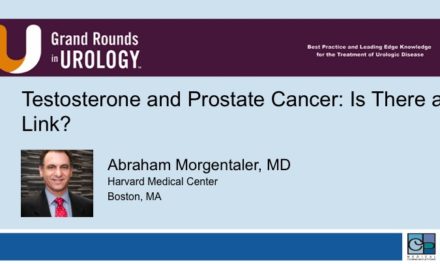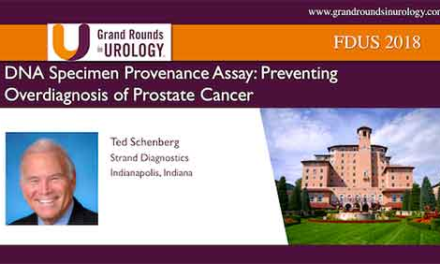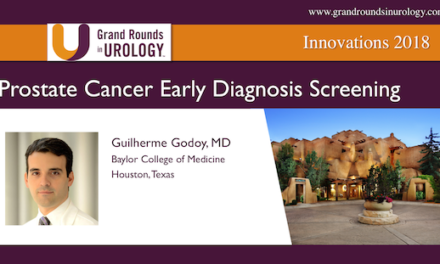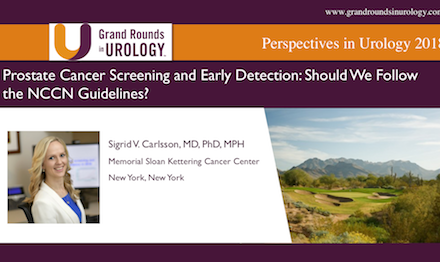Gerald L. Andriole, Jr., MD presented “” at the 27th annual International Prostate Cancer Update meeting on Wednesday, January 25, 2017.
Keywords: prostate cancer, USPSTF, biopsy, metastatic, focal therapy
How to cite: Andriole, Gerald L. “Impact of the USPSTF Recommendations on Screening”. January 25, 2017. Accessed Dec 2024. https://dev.grandroundsinurology.com/impact-uspstf-recommendations-screening
Transcript
Impact of the USPSTF Recommendations on Screening
I’m going to talk about the impact of the Preventative Service recommendation in 2012 against screening for prostate cancer. And just to summarize it, I’m sure everybody in the room knows, it received a grade D recommendation, which means that the US Preventive Services Task Force has concluded that there is at least a moderate certainly that the harms of performing the intervention equal or outweigh the benefits in the target population. And here’s the actual paper that was published in the Annual in Internal Medicine. And by and large, the data that they used to come to that conclusion were derived from the PLCO cancer screening trial and the European randomized screening trial for prostate cancer, and collectively they showed that for men between the ages of 55 and 69 if they are screened annually or over an interval every four years that for a 1,000 men screened for a decade you’d save somewhere between zero and one lives at the cost of a certain number of false positive, unnecessary biopsies and so on and so forth.
So what happened in the spring of 2012 when this recommendation came out, well, like everything, there was an acute reaction. And then there’s been the medical community’s reaction at large over the last three to four years. So here’s the acute reaction by a prominent American academic urologist on Twitter saying that “I hope that Task Force member Tim Wilt knows in his heart of hearts that thousands of painful, slow, preventative deaths will be indisputably on his head.” That’s a pretty rough thing to say. Now, I guess he realized that, he tried to take it down but Declan Murphy and some others had re-Tweeted is, and once it was out there is was out there. And he wasn’t the only one sort of saying challenging things. Otis Brawley, who was at the NCI at the time and is now at the American Cancer Society, who wasn’t even part of the Task Force, is accused of having killed more men by giving them an excuse not to be treated. There was a reporter for USA Today who realized that when a screening guideline against breast cancer had come out a few years prior there was a very, very big uproar. So she kept track of what was going on in social media. And she characterized many of the acute reactions as depressing and ugly. One person, “One can only hope that all of those on this panel who made this decision, and Dr. Otis Brawley, all get cancer and find out too late.” “Could someone please tell me how it is that Virginia Moyer, a pediatrician and a woman is chair of a committee considering a man’s issue on cancer?” “This is a democratic war on men. They obviously want us all to die from prostate cancer.” “This is a prelude to the world of death panels where ignorant bureaucrats make your health decisions for you.” This one I like. This lady I think got it right. She says, “A scientist, especially one who disagrees with you, is the first one to tell you that the plural of antidotes is not evidence, but that seems to be the urologists only come back to the evidence examined by the Task Force.” Sure, every urologist would say, “Oh no, I just saw this guy. His PSA was 5,000. If he had only had his PSA a year or so prior, whatever, I would have been able to cure him.” Well, you don’t really know that that’s a fact.
So that was sort of the acute and ugly reaction. What has happened since? So I’m going to chronologically review a number of papers starting about two years ago that have showed what’s been going on. You can see here, and by the way, most of these papers look at different datasets, and each of the datasets has their strengths and weaknesses, but they’re telling pretty much the same story, that after the recommendation came out the incidents of newly diagnosed—wait, this is percent of men getting a PSA test has dropped in just a few years after the screening recommendation was made. The curious thing, and this is a real problem for the medical community at large, is that it’s much more likely that a man over the age of 75 gets a PSA test than the younger man. And that’s sort of part of the issue we’ve created as a medical community, we’ve probably been testing the wrong people overall. Otis Brawley and his people, again, about two years ago looked at what was happening in terms of the incidence of prostate cancer, and they showed that over the 1.5 years since the implementation that the rate of testing is only about 82% of what it had been in the index years prior to the institution of the guideline. And that this was true both for men between the ages of 50 and 74, and even for men over the age of 75.
These are data from the National Cancer Database, just looking at diagnoses of prostate cancer. And you can see low risk, intermediate risk, and high-risk disease is generally being diagnosed less commonly in the year or two after the guideline was issued. And you can see the fairly steep drop-off when you’re looking at even the target population of patients between the ages of 50 and 74.
These are data from the SEER dataset reported recently at the SUO meeting in San Antonio, that again, between 2008 and 2013 about a 9% reduction in diagnosis of low-risk cancer, 9% intermediate risk, and only a smaller 5% reduction in high-risk prostate cancer.
This was an interesting other way of looking at it. They looked at the case logs that young urologists were submitting to the American Board of Urology to sit for part 2 of the oral boards. And so in the years prior to the Task Force, 09 to 012, the average applicant said that he had done, or she had done 29 biopsies. In the post US Preventative Services that declined to 21. You can see there were differences. The average male candidate did 30 versus 11 for woman, 22 versus 10 in the post biopsy, in the post Preventative Task Force era. So overall, based on this, the total number of annual biopsies performed by candidates sitting for part 2 of the boards declined by 12.7%, the greatest decrease in biopsy volume was seen in those biopsies performed for an abnormal PSA. And remember, this was actually counteracted by the fact that biopsy volume for an indication of cancer surveillance had actually increased during that study period. So there are sort of two effects going on here.
Male urology sex was associated with higher biopsy volume; whereas, oncological specialty was associated with a lower biopsy volume. And I should say that this issue of gender differences by physicians might be sort of the next kind of big thing that we’re going to hear about, because this paper came out just a few weeks ago looking at over a million discharges by hospitalists in the United States. And what it showed was whereas there was just only a small absolute difference in mortality of patients treated by male physicians versus female physicians, it was statistically significantly better to be treated by a female than by a male physician. So I think gender differences in healthcare delivery is something that we’re going to be hearing more and more about.
But anyway, back to the candidate sitting for part 2 of the boards in urology, prior to the Task Force recommendation the average urologist candidates had done seven radical prostatectomies, that fell to six, and you can see the gender differences, and so forth. So after adjusting for physician and patient characteristics there remained a 16.2% decrease in radical prostatectomy following the Task Force guidelines.
This is a paper from the group at the American Cancer Society looking at the stage of disease. So this is locally advanced, and this metastatic, and you can see while the rate or the incidence of metastatic disease seems to be rising, it’s not yet statistically significant. And I think most people would agree that just a few years after stopping or reducing PSA screening it’s probably not enough time to see any increase in metastatic disease, at least on that analysis. And there are a number of different analyses looking at the datasets of older men versus younger men. You can see they’re actually fairly constant. In absolute terms the proportion of patients diagnosed with metastatic disease seems to be rising for men who are young, and even for men who are old, but the main criticism to this paper that was posted on Twitter is that when you curb over-diagnosis you leave behind a higher percentage of real cancer; therefore, this is a pointless study. The editorialists reviewing this paper said it is possible that the seemingly contradictory results of that study showing, or suggesting a slight increase in metastatic disease and the other studies are simply a statistical random variation of incidence that can change over time depending on a lot of different things. And furthermore, in the articles that analyze SEER data, for example, there are different ways of coding the stage of patients. So I think at this point just a few years after the guideline it’s not yet possible to say that the incidence of metastatic disease has risen.
This paper from Ted Shafer suggests that, but again, it’s criticized for the same reason. But the point I want to make is that the incidence of metastatic disease seem to be rising even before the Preventative Services Task Force guideline was issued. The American Cancer Society published the cancer statistics just maybe a week or two ago. And you can see the prostate cancer death rate looks like it was falling and continued to fall, at least according to their calculations as of 2014. And you can see the incidence of prostate cancer peaking in 1992ish or so, and then now coming back almost to the pre-PSA era level of prostate cancer, despite the fact that the population is now older than it was then.
Nice paper from the group at Michigan in Health Affairs that just came out a few weeks ago. A trend in the rate of curative prostate cancer treatments for all men eligible for screening, but notice this ended in 2012, their dataset, and the incidence of treating prostate cancer was actually falling prior to the Task Force guideline; however, if you are diagnosed with prostate cancer you’re nearly as likely in 2012 to be aggressively treated as you were in 2007. But we do know that very, very recently the rates of active surveillance have started to rise. And the curious thing about this paper, and again, this is something we should all pay attention to, that men in the highest quartile of ten year expected mortality still half of those patients were getting aggressively treated for prostate cancer.
So I think since the Task Force recommendation in 2012, which by the way, is going to be re-reviewed this year, and I’m told that a urologist, at least one urologist will be on the panel, so there’s apt to be—
MALE VOICE 1: Who is that?
ANDRIOLE: We don’t know yet. I think the AUA nominated a few different people, probably possibly people in this room. But that will be good to have a urologist at the table. I think it’s clear to say there’s been fewer PSA tests ordered. That there have been likely lower rates of biopsy, cancer detection, certainly radical prostatectomy, I don’t know about radiation therapy. I think there’s a possible increase in distant disease, but we don’t know that yet because it’s probably not been long enough to see that play out. My hope, we’ll hear about this a lot in this meeting is to make PSA great again. We need to test the men who need to be tested. We need to consider reflex tests if the PSA is abnormal. I think we need to do a quality biopsy. I don’t know if that’s MRI or transperineal, and we need to avoid overtreatment. So thanks very, very much.
ABOUT THE AUTHOR
Gerald L. Andriole, Jr., MD, is the Robert K. Royce Distinguished Professor and Chief of Urologic Surgery at Barnes-Jewish Hospital, the Siteman Cancer Center, and Washington University School of Medicine in St. Louis, Missouri.
Dr. Andriole received his medical degree from Jefferson Medical College in Philadelphia, Pennsylvania. He trained in surgery at Strong Memorial Hospital and the University of Rochester and completed his Urology Residency at Brigham and Women’s Hospital and Harvard Medical School. Subsequently, he was a Fellow in Urologic Oncology at the National Cancer Institute in Bethesda, Maryland.
Dr. Andriole has over 35 years of consistent contributions in the areas of BPH and prostate cancer screening and prevention research. He has contributed well over 400 peer-reviewed publications and serves on the editorial boards of several prestigious journals. He is Chairman of the Prostate Committee of the National Cancer Institute’s Prostate, Lung, Colorectal and Ovarian (PLCO) Cancer Screening Trial, and PI of the NIDDK Multidisciplinary Approach to Urologic Pelvic Pain (MAPP) and Symptoms of Lower Urinary Tract Dysfunction Research Network (LURN). He was Chairman of the Steering Committee of the REDUCE Prostate Cancer Prevention Trial, as well as PI of both the NIDDK Medical Therapy of Prostatic Symptoms (MTOPS) BPH trial and the NIDDK Complementary and Alternative Medicine for Urinary Symptoms (CAMUS) study. He is a member of the American Urological Association, the American Association for Cancer Research, the American Society of Clinical Oncology, the American Surgical Association, the American Association of Genitourinary Surgeons, and the Clinical Society of Genitourinary Surgeons, among other societies.





